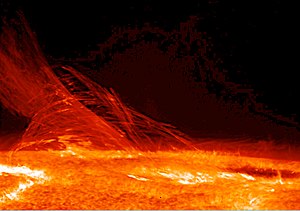 Image via Wikipedia
Image via Wikipedia
Not all people should receive massage. There are contraindications and situations where a massage can be directly harmful. When you use heat and cold in a massage, these multiply and you need to be even more aware of the conditions the client has and how to deal with them.
Temperature extremes stresses the immune system, which is no problem and actually beneficial for those who’re healthy and with a normal immune system. It’s good for it to get a bit of work to do once in a while to keep it in shape and ready.
But when people have a stressed immune system, applying heat and cold can become too much for it, with the risk of rendering it less effective in dealing with the real challenges. This is why it’s generally advised that people who’re sick do not get a massage, and especially not thermal therapy. That said, massage and thermal can help in the recovery phase, or with minor issues. This is where the therapist must take these things into consideration and adjust the treatment accordingly.
There are three areas where the therapist can adjust her treatment. The length, the temperatures and the techniques. If a client has a condition, it’s always wise to lower the temperature to perhaps 40 degrees Celsius for the hot and room temperature for the cold, shorten the treatment to maybe just half an hour and use light and gentle techniques when massaging.
It is also essential that the client gives constant feedback and instantly informs the therapist if anything feels uncomfortable or painful. If it’s too hot or too cold and describe what reactions and feelings that might happen.
Over a period of treatments, the temperature, techniques and length can be adjusted to suit the client’s condition and situation. This allows the client to gain the benefits of thermal therapy and massage without putting him at risk.
There are of course situations where a client shouldn’t receive a thermal massage under any conditions, unless the therapists is especially trained to deal with it. These includes:
- Thrombosis/embolism
- Contagious skin diseases
- Cancer
- Pregnancy
Conditions where a LaStone massage can be given, but precautions and special attention must be given, including using special techniques and reducing temperature or length:
- Epilepsy
- Diabetes
- Heart conditions
- Bruising
- Sunburn
- Psoriasis
- High blood pressure
- Low blood pressure
- Asthma
- Any condition where normal massage is contraindicated
In short, if the immune system is under any form of stress, then that must be taken into account and the treatment be adjusted accordingly, or avoided all together. There are luckily many other treatments and therapies which only apply minimal physical manipulation, such as Reiki, Craniosacral therapy and aromatherapy.
Make sure that your therapist are aware of the contraindications for a thermal massage and who to adjust her treatment according to the condition of the client. It’s even more important when using temperature than during a normal massage, so be certain that your therapist is properly qualified and knowledgeable.
![Reblog this post [with Zemanta]](http://img.zemanta.com/reblog_e.png?x-id=8034a1ec-7b90-49e3-9b57-bd50ddaad52c)
Very thoughtfull post on wellness. It should be very much helpfull
Thanks,
Karim – Positive thinking
Posted by John | Saturday 19 September, 2009, 06:06Very thoughtfull post on wellness. It should be very much helpfull
Thanks,
Karim – Positive thinking
Posted by John | Saturday 19 September, 2009, 06:06